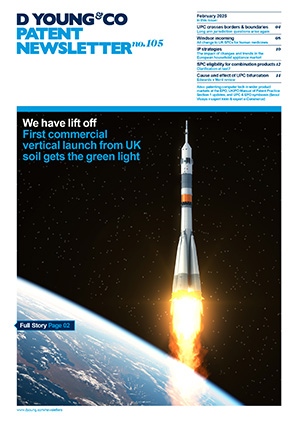How can I patent products made by 3D printing? Challenges posed by latest EPO guidance on additive manufacture
Recent years have seen rapid growth in the use of additive manufacturing, also known as 3D printing. Additive manufacture can help to enable intricate design geometries which would not be feasible using traditional manufacturing techniques, allow bespoke parts to be created on-site based on scanning of requirements (for example, dental implants made based on a scanning of moulds taken from a patient), and reduce distribution costs by transmitting the product electronically as a 3D model, rather than shipping a physical product. This last point may create challenges for those who are seeking protection for their innovations.
Although other forms of intellectual property can also be considered in some cases, if the innovation is based on a technical principle which could be implemented in a variety of designs with different visual appearances, patents may be the most useful form of IP right.
A practical example
Assume that an innovator is able to obtain a valid patent that includes a product claim that defines the functional or physical characteristics of a 3D-printable product. This innovator wishes to use the patent to prevent loss of income due to their potential customer’s 3D printing a product based on a design supplied electronically by a competitor, instead of buying from the innovator.
If the customer is doing the 3D printing in a country covered by the patent, then the customer is arguably the manufacturer who infringes the patent. However, the innovator may be reluctant to pursue their own potential customers for patent infringement, and there may be a prohibitively large number of customers to pursue. It may be more efficient for the innovator to target the acts done by the competitor, rather than the customers.
It could be argued that the competitor has directly infringed the product claim by supplying a patented product to the customer. However, there may be uncertainty over whether a court would rule that an electronic representation of the product is covered by a claim to an apparatus having certain functional or physical features. Another argument could be that the competitor jointly infringes the patent with the customer because they procured the act of infringement by the customer who manufactured the patented product, but this would bring the customer into the dispute. Also, it could be argued that the competitor indirectly infringes the product claim by supplying, as “means relating to an essential element of the invention”, the electronic file defining the 3D geometry of the product, knowing that the customer intends to use it to manufacture the product. However, indirect infringement can be harder to prove than direct infringement, and may require that both the competitor and customer are in the same country or other territory covered by a single patent.
What if the competitor is in a country covered by the patent, but the customer is not? The above lines of argument would be unlikely to help in that case. To deal with this scenario, it can be useful to include in the patent a claim defining a data structure providing a digital representation of the product. This could allow you to argue that, as the patented “product” is the data structure rather than the physical product, the competitor directly infringes by “manufacturing” the claimed data structure when they create the computer-aided-design (CAD) model of the product.
However, D Young & Co’s experience has been that there can be considerable divergence in how patent examiners handle such claims to a digital representation of the product. We have seen similar claim wording accepted by one examiner but rejected by another at the same patent office.
EPO Guidelines for Examinations
In the most recent update of its Guidelines for Examination the European Patent Office (EPO) has clarified the extent to which claims to a digital representation of the geometry of an object are patentable. On the one hand the new guidance is helpful in confirming that protection is available for such claims, contrary to the position of some examiners who argue that such claims can never be allowed.
However, the EPO has caveated its guidance by stating that, for a computer-readable medium storing data representing the geometry of a 3D printable device to be patentable, it would be required that the data “defines the instructions for operating the AM [additive manufacturing] device”. The EPO’s reasoning is that it has been established in case law that abstract descriptions or models are not considered technical, even if the entity described by that model is technical, so something more is needed to provide the “technical effect” required for patentability. The EPO’s position is that if the claim encompasses data which only defines a digital description or 3D model of the product, but the claimed data is not defined as specifically adapted to additive manufacturing of the product, that data could be used to merely visualise the product in a CAD software tool, which is considered not to be a technical use of the data.
Example EPO claim wording
Therefore, the EPO’s recommended example claim wording is: “A computer-readable medium storing data which defines both a digital representation of the product of claim 1 and operating instructions adapted to control an AM device to fabricate the product using the digital representation of the product when said data is relayed to the AM device”.
This guidance is perhaps unhelpful to innovators of 3D-printable products, because the file which is transmitted electronically to the customer may be in a format such as STL or OBJ, which merely defines a general 3D model indicating the product geometry, but does not comprise specific instructions for a 3D printer. In practice, the actions for creating such 3D printer instructions (for example, slicing the 3D model to generate a series of 2D layers, and mapping each layer of the sliced model to the instructions for controlling the 3D printer to lay down material for each layer) may take place at the 3D printer itself. Therefore, the EPO’s example claim might still leave some scope for a competitor in a patented territory who creates and supplies a 3D model file to a customer outside the territory to argue they do not infringe because they do not provide instructions for controlling an AM device.
Strategies for patent protection
So what should be done to increase the chances of gaining effective patent protection for a 3D printable product? Although there is some uncertainty in this area this is not a reason not to pursue patent protection at all. It may be better to have an intellectual property right which creates uncertainty for your competitors than to have no such right at all. Also, the patent may still have value in protecting against infringement based on the product being manufactured by traditional subtractive manufacturing techniques.
However, to increase the options, our practical advice is to include in the patent both a conventional product claim, defining the product in terms of its physical features, and a claim to a digital representation of the product which is filed initially without specifying the operating instructions adapted to control an additive manufacturing device. Also include (either as a further dependent claim or in the description of the patent), basis for restricting the digital representation claim to being adapted for control of an additive manufacturing device. By filing the broader wording of the product claim initially, this can give wider options in case patent offices in some countries are less strict than the EPO or the case law changes in future. However, including the fallback option means you can retreat if necessary. In any case, including the digital representation claim widens the options for arguing for infringement compared to a patent including only the product claim itself.

